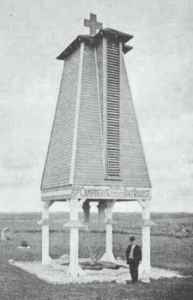Background
information
Australian animals, tree hollows and nestboxes
Australian topics
Nankeen kestrel
Eastern pygmy possum
Green tree frog
Microbats general
Batboxes in
Organ Pipes National Park
Gould's wattled bat
Chocolate wattled bat
Large-footed myotis
Bats, Mosquitoes and Dollars
| Bats, Mosquitoes and Dollars |
|
|
| Home / Contact us / Product range / Stories / Pest management / Prices |
|
Bats, Mosquitoes and Dollars is a small book by Dr Chas Campbell, published in 1925. Dr Campbell was a renowned bacteriologist who discovered the agent that spread smallpox. He was nominated for the Nobel Prize for Medicine in 1919 for his efforts towards the eradication of malaria by the cultivation of bats, the natural enemy of mosquitoes. Campbell experimented with natural methods of mosquito control in the days before pesticides and is a fascinating read. In the book, Campbell describes how the
idea of mosquito control using bats first came to him. He had been
called to a friend’s room on the third floor of a hotel in the CBD of an American
town. The hotel was not gauzed. The two of them were sitting on the floor at 4.30am gazing
out at the approaching dawn through an open window. |
|
"It was not long before a bat flew by, then another and another. On looking out the window, the author counted the bats. There were just four bats flying backwards and forwards on the hotel side of the street. Presently we saw an engorged mosquito flying slowly out of the window, being burdened with an abdomen full of blood. It had not gone three feet from the wall when a bat got it in plain sight of both of us." The author was (spellbound), not at the sight of one engorged
mosquito being waylaid by the bats, but at seeing every one that left the room captured
with the most dextrous and unerring certainty. Not a single mosquito escaped our
eager eyes, neither did it escape the keen ears of the noiselessly-flying, acrobatic
sentinels on the outside of the room." |
Campbell’s first successful bat roost, built in 1911. |
If bats were the natural enemy of mosquitoes, Campbell believed that mosquitos must have developed a defence strategy. If so, it would be another argument for encouraging bats. He devised an experiment. "A small room, 10 feet long, 5 feet wide and 51/2 feet high, was thoroughly cleaned, canvassed and white-washed. The room had one small window to the east and a door to the west, both of which were thoroughly screened with fine wire mesh. Tens of thousands of mosquito eggs were procured and placed in a tub of cistern water, to which there was previously added some organic matter to furnish food for the larvae. In the course of time thousands of mosquitoes hatched out and these were fed by placing two turkeys and two old fat hens in the room until all the mosquitoes were hatched." "At night, after the mosquitoes had developed into
adult insects, their buzzing noise could be plainly heard several feet from the room. On
one occasion the writer entered the room with a darkened electric flash light and
liberated two bats. Instantly the buzzing noise ceased and, on turning on the light, it
was observed that the mosquitoes were clinging to the walls and perfectly motionless. On
taking the bats out of the room, in less than three minutes the buzzing noise resumed.
This experiment was repeated several times with the same results." |
|
After several futile attempts, Campbell did succeed in building a successful bat roost in front of a large lake in 1911. The surrounds of the lake were tenanted by Mexican and Spanish farmers and the book contains many testimonials by these families. Here is one. "This is to certify that we, Cesario and Ramon Miranda, have lived on Mitchell’s Lake since 1907. During the years 1907-1910, mosquitoes appeared in clouds. In 1909 we were both very ill with malaria. In those years it was a sacrifice for us to irrigate at night and no one would help us for any amount of money. During the day it was almost impossible for us to rest on account of the mosquitoes. Since the bat roost was erected, we have noticed a (steady) change. During 1912-13, we were able to irrigate at night and since 1911 we have had no signs of malaria." The entire book is available
on-line at http://www.whale.to/a/camppref.html
- inspiring. |
By 1917, the bat roost was producing 1.3 tonnes of bat guano annually, which was harvested and sold as fertiliser. |


